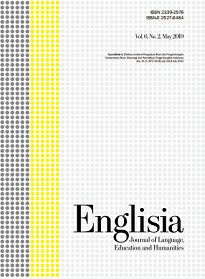Teacher-student interaction in English class at state senior high school in Banjarbaru
DOI:
https://doi.org/10.22373/ej.v9i2.10843Keywords:
Anxiety, Flander’s category, InteractionAbstract
This study investigated the interaction happened in English class at State Senior High School 3 in Banjarbaru, South Kalimantan. English teacher and Class 11 students at Senior High school 3 in Banjarbaru were the research subjects. The object of the research was classroom interaction. Purposive sampling was used in determining the research sample. Flanders Interaction Analysis Category as an observation guide and interviews were used to collect the data in the class. The results indicate that two-way communication among teacher, student, and students occurred in English class. The findings revealed that teacher-talk was 42.79% and student-talk was 53.79%, while silence or confusion was 3.40%. It indicated that two-way communication between teacher and students occurred in English Class. It shows that students are the center of learning process and the students are active during English learning process. However, this study differs from previous studies as the Flanders Interaction Analysis Category used here was analyzed according to the perspectives of foreign language anxiety.
Downloads
References
Aida, Y. (1994). Examination of Horwitz, Horwitz, and Cope’s Construct of Foreign Language Anxiety: The Case of Students of Japanese. The Modern Language Journal, 78(2), 155–168. https://doi.org/10.1111/j.1540-4781.1994.tb02026.x
Allwright, D., & Bailey, K. M. (1991). Focus on the language classroom: An introduction to classroom research for language teachers. Cambridge University Press.
Ansari, A., Hofkens, T. L., & Pianta, R. C. (2020). Teacher-student relationships across the first seven years of education and adolescent outcomes. Journal of Applied Developmental Psychology, 71, 101200. https://doi.org/10.1016/j.appdev.2020.101200
Breen, M. P., & Candlin, C. (1980). The essentials of a communicative curriculum in language teaching. Applied linguistics, 1(2), 89–112.
Chang, S. (2003). L2 Learning through Interaction: English Learning in An Adult IEP Classroom [University of Georgia]. https://getd.libs.uga.edu/pdfs/chang_sunmee_200308_phd.pdf
Collier-Meek, M. A., Johnson, A. H., Sanetti, L. H., & Minami, T. (2019). Identifying Critical Components of Classroom Management Implementation. School Psychology Review, 48(4), 348–361. https://doi.org/10.17105/SPR-2018-0026.V48-4
Dagarin, M. (2004). Classroom Interaction and Communication Strategies in Learning English as a Foreign Language. ELOPE: English Language Overseas Perspectives and Enquiries, 1(1–2), 127–139. https://doi.org/10.4312/elope.1.1-2.127-139
Dahliana, S. (2019). Students’ Motivation And Responsive Pedagogy In Language Classroom. Englisia Journal, 6(2), 75. https://doi.org/10.22373/ej.v6i2.4601
Elkhafaifi, H. (2005). Listening Comprehension and Anxiety in the Arabic Language Classroom. The Modern Language Journal, 89(2), 206–220. https://doi.org/10.1111/j.1540-4781.2005.00275.x
Fadillah, R. (2016). The Effectiveness of Dynamic Discussion Model in English Learning. SSRN Electronic Journal. https://doi.org/10.2139/ssrn.2804022
Flanders, N. A. (1970). Analyzing teaching behavior. Addison-Wesley Pub. Co.
Gregersen, T., & Horwitz, E. K. (2002). Language Learning and Perfectionism: Anxious and Non-Anxious Language Learners’ Reactions to Their Own Oral Performance. The Modern Language Journal, 86, 562–570.
Harmer, J. (2007). How to teach English. Buch (New ed., 6. impr). Pearson/Longman.
Herman, R. I. (2019). Study on the Impact of the Continuous Training Program Classroom Management—Effective Strategies. Educația Plus, 25(2), 155–163.
Horwitz, E. K., Horwitz, M. B., & Cope, J. (1986). Foreign Language Classroom Anxiety. The Modern Language Journal, 70(2), 125–132. https://doi.org/10.1111/j.1540-4781.1986.tb05256.x
Jafari, S., & Asgari, A. (2020). Predicting Students’ Academic Achievement Based on the Classroom Climate, Mediating Role of Teacher-Student Interaction and Academic Motivation. Integration of Education, 24(1), 62–74. https://doi.org/10.15507/1991-9468.098.024.202001.062-074
Jia, X. (2013). The Application of Classroom Interaction in English Lesson. Proceedings of the 2013 the International Conference on Education Technology and Information Systems. 2013 the International Conference on Education Technology and Information Systems (ICETIS 2013), Sanya, China. https://doi.org/10.2991/icetis-13.2013.46
Khusnaini, N. (2019). The Analysis of Teacher Talk and The Characteristic of Classroom Interaction in English for Young Learner. ELT Forum: Journal of English Language Teaching, 8(2), 166–174. https://doi.org/10.15294/elt.v8i2.32716
Meida, S. N., & Fadhly, F. Z. (2018). THE ANALYSIS OF TEACHER AND STUDENTS TALK IN INDONESIAN EFL CLASSROOM INTERACTION. Indonesian EFL Journal, 4(1), 73. https://doi.org/10.25134/ieflj.v4i1.886
Nurmasitah, S. (2010). A Study of Classroom Interaction Characteristics in A Geography Class Conducted in English: The Case at Year Ten of An Immersion Class in SMAN 2 Semarang [Unpublished Dissertation, Universitas Diponegoro]. http://eprints.undip.ac.id/23803/
Saito, Y., & Samimy, K. K. (1996). Foreign Language Anxiety and Language Performance: A Study of Learner Anxiety in Beginning, Intermediate, and Advanced-Level College Students of Japanese. Foreign Language Annals, 29(2), 239–249. https://doi.org/10.1111/j.1944-9720.1996.tb02330.x
Sofyan, R. R., & Mahmud, M. (2014). Teacher Talk in Classroom Interaction: A Study at an English Department in Indonesia. ELT Worldwide: Journal of English Language Teaching, 1(1), 45. https://doi.org/10.26858/eltww.v1i1.841
Solita, R., Harahap, A., & Lubis, A. A. (2021). Teacher Talk in English Foreign Language Classroom. Journal of English Education and Teaching, 5(2), 302–316. https://doi.org/10.33369/jeet.5.2.302-316
Wang, Q., & Castro, D. C. (2010). Classroom Interaction and Language Output. English Language Teaching, 3(2), 175–186.
Woodrow, L. (2006). Anxiety and Speaking English as a Second Language. RELC Journal, 37(3), 308–328. https://doi.org/10.1177/0033688206071315
Downloads
Published
Issue
Section
License
Proposed Policy for Journals That Offer Open Access
Authors who publish with Englisia journal agree to the following terms:
- Authors retain copyright and grant the journal right of first publication with the work simultaneously licensed under a Creative Commons Attribution License that allows others to share the work with an acknowledgement of the work's authorship and initial publication in this journal.
- Authors are able to enter into separate, additional contractual arrangements for the non-exclusive distribution of the journal's published version of the work (e.g., post it to an institutional repository or publish it in a book), with an acknowledgement of its initial publication in this journal.
- Authors are permitted and encouraged to post their work online (e.g., in institutional repositories or on their website) prior to and during the submission process, as it can lead to productive exchanges, as well as earlier and greater citation of published work (See The Effect of Open Access).









